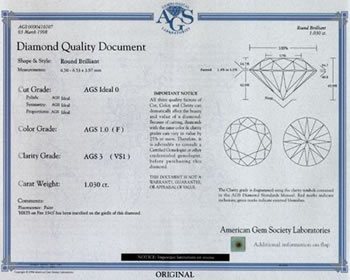 The AGS Gemological Laboratory is equal to or stricter than GIA. The AGS diamond quality document, commonly called an AGS certification, provides a carefully drawn plot which illustrates the exact position, size and shape of every internal inclusion and external blemish a diamond possesses in addition to a complete full analysis of diamond proportion, color and clarity.
The AGS Gemological Laboratory is equal to or stricter than GIA. The AGS diamond quality document, commonly called an AGS certification, provides a carefully drawn plot which illustrates the exact position, size and shape of every internal inclusion and external blemish a diamond possesses in addition to a complete full analysis of diamond proportion, color and clarity.
The AGS is the only gemological laboratory that assigns a cut grade as a numerical value between 0 and 10. The AGS system of defining cut grade is modeled after the Tolkowsky theoretical ideal brilliant which is a standard of ideal proportions and facet angles that were mathematically calculated by Marcel Tolkowsky in 1919. It also carefully considers important aspects of diamond polish and symmetry in the assignment of a cut grade. An ideal cut diamond is assigned AGS 0-cut grade. Small incremental proportion deviations from the ideal cut model assign the next higher numerical cut grade. Cut grades 1 and 2 are still considered very fine.
Fewer diamonds are available with AGS Diamond Quality Documents (AGS Certifications) compared to GIA or EGL certifications. AGS certifications are most often used by diamond cutters who wish to confirm near ideal or ideal cut diamonds. Cutters and wholesalers seldom send average or poorly cut diamonds to the AGS.
Don’t confuse an AGS diamond quality report with an AGS Member Jeweler’s appraisal or opinion. An American Gem Society (AGS) Member Jeweler does not have power to validate grades on behalf of AGS, or issue an official AGS report.
AGS Certifications

AGS Diamond Quality Reports provide the following information:
AGSL Number: Unique number assigned to each Diamond Quality Document
Date: Date the Diamond Quality Document was issued
Weight: Carat weight of diamond measured to one thousandths of carat
Shape and Style: Description of the diamond shape
Measurements: Length, width and depth of diamond measured in millimeters
Cut Grade: 0=Ideal, 1=Excellent, 2=Very Good, 3-4=Good, 5-7=Fair, 8-10=Poor In assigning a Cut Grade, seven factors are considered: five proportion factors, polish and symmetry.
Polish: Rating (Ideal, Excellent, Good, Fair, Poor) of polish marks left from polishing wheel used by diamond cutters to polish the facets of the diamond after cutting.
Symmetry: Rating (Ideal, Excellent, Good, Fair, Poor) of balance and alignment of the facets.
Proportions: Table %, crown angle, pavilion depth %, girdle thickness % and culet size are evaluated against specific standards and a composite rating (Ideal, Excellent, Good, Fair, Poor) assigned.
Color Grade: 0=D, 0.5=E, 1.0=F, 1.5=G, 2.0=H, I=2.5, J=3.0, 3.5=K, etc.
Clarity Grade: 0=FL/IF, 1=VVS1, 2=VVS2, 3=VS1, 4=VS2, 5=SI1, 6=SI2, 7=I1
Comments: This is the “catch all” area for AGS certifications. Clarity characteristics that are not plotted are mentioned here. If a diamond has been enhanced by laser drilling, a comment will appear here as well. Surface or finish comments will also appear here for those diamonds that are equivalent to the GIA’s Internally Flawless grade. If the diamond is laser inscribed, the inscription will be described here. The strength and color of the diamond’s fluorescence, when exposed to long wave ultraviolet light, is noted in this section. The nomenclature is: negligible, medium, strong, very strong. Negligible replaced inert and faint effective January 1, 2003. The color of the fluorescence is only noted at strengths medium and greater.
Diamond Profile: This side view of a Round Brilliant diamond is where all the proportion information for each diamond is printed. The 100% figure represents the average diameter of a round stone and the width of a fancy shape. At a glance, the table %, crown height %, crown angle, girdle condition, minimum and maximum girdle thickness %, pavilion depth %, pavilion angle, culet size, culet condition (abraded or chipped), and total depth % are displayed in this section.
Plot: The crown and pavilion views of the plot are printed directly on the Diamond Quality Document. This feature is unique. Other laboratories have to use a peel and stick label. For Round Brilliant diamonds, the AGS Laboratories is able to print the crown view with the correct table diameter %. If a diamond has a 54% table, the crown view will show a 54% table. If the diamond has a 68% table, the crown view will show a 68% table.
Flap: The flap contains visual representations of the Cut, Color and Clarity Scales, as well as the Key to Symbols. The Color and Clarity Scales cross reference to equivalent GIA grades.
New AGS Cut Grades
